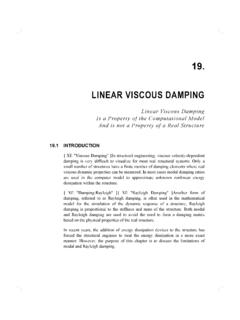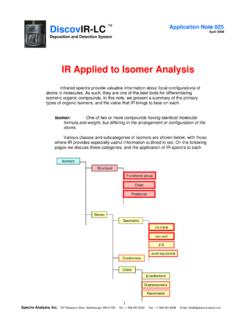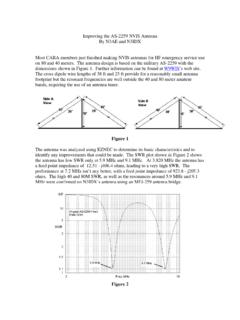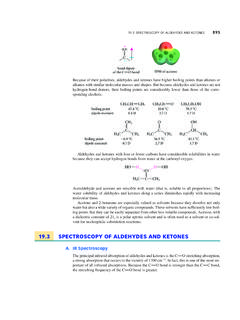Transcription of Practical Calculations for Designing a Newtonian …
1 Practical Calculations for Designing a Newtonian Telescope Jeff Beish ( Rev. 05 August 2016 ) INTRODUCTION A Newtonian reflecting telescope can be designed to perform more efficiently than any other type of optical system, if one is careful to follow the laws of nature. One must have optics made from precision Pyrex or a similar material and figured to a high quality. The mounting hardware must be well planned out and properly constructed using highest quality materials. The Newtonian can be used for visual or photographic work, for "deep sky" or "planetary" observing, or a combination of all these. They are easy to layout and to construct using simple household tools. The design mathematics is simple and can be easily accomplished by hand calculator. The Newtonian reflector can be easily modified for other types of observing such a photometry, photography, CCD imaging, micrometer work, and more.
2 Since a reflecting telescope does not suffer for chromatic aberration we don't have to worry about focusing each color while observing or photographing with filters as we would in a single or double lens refractor. This is a problem especially associated with photography. Since the introduction of the relatively low cost Apochromatic refractors (APO) in the past few years these problems no longer hamper the astrophotographer as much. However, the cost of large APO's for those requiring large apertures is prohibitive to most of us who require instruments above 12 or so inches. Remember, even with the highest quality optics a Newtonian can be rendered nearly useless by tube currents, misaligned components, mirror stain, and a secondary mirror too large for the application of the instrument. The size of the Newtonian secondary and how it affects image contrast will be the main topic discussed here.
3 Many of the design principles used for this telescope can be found in my articles published over the years [Beish, 1994, 1994, 1994, 2000 and 2008]. We theorize that 84% of the light falls in the central spot, or "Airy Disc," in the first bright ring, in the second, and and in the third and forth rings. I derived an equation from tables published in the referenced articles and came up with an equation: CF = - - + , where x is the obstruction ratio (NOTE: an unobstructed telescope yields a CF of : 1) Designing a Newtonian Optical System An important thing to remember is to keep the distance from the secondary mirror to the focal point to a minimum. This aligns the secondary mirror in a smaller angle within the optical path that is closer to the focal point and results in a smaller mirror. To accomplish this one must use a tube diameter as small as possible to allow some air flow around the primary mirror.
4 Also in keeping the secondary mirror to the focal point to a minimum one must select a low profile focuser available on the market. The material edge of the overlap rim that secures the mirror in the holder only reduces the illumination a little, but adds some diffraction in the final image that is similar to spider diffraction. One may wish to glue the mirror onto the holder without a rim or even the outer material that surrounds the mirror. For comprehensive instructions for gluing a Newtonian Secondary see: . If a standard secondary holder is used then the clear aperture (c) of the secondary mirror will be reduced by the amount of the rim overlap that secures the mirror in the holder. Also, the holder material will add a slight amount to the obstruction and should be as thin as possible. The typical Newtonian secondary mirror holder is usually made from 26 to 30 gauge ( " - ") aluminum stock so the thickness of the holder material adds very little to the obstruction of the secondary mirror.
5 Figure 1. A typical secondary mirror in holder with overlap rim to secure mirror in place. SECONDARY TO FOCAL POINT The Newtonian secondary mirror, or diagonal, is usually centered within the telescope at a point near the opposite end of the tube from the primary mirror. The distance from the secondary mirror to the focal point ( l ) can be found by dividing the outside diameter of the tube (T) by two and adding the length of the fully racked-in focuser (H). This distance becomes important when selecting the final image size and size of the secondary mirror. The size of the secondary mirror is a key aspect when attempting to optimize our telescope for maximum efficiency. Some telescope makers add a quarter-inch ( ) to allow for variations in eyepiece field stop positions. A word of caution: make sure the inside drawtube does interfere with the optical path when mounting any focuser on a Newtonian telescope.
6 Figure 2. LEFT: Novak low profile helical focuser with 1-1/4-inch adapter insert. CENTER: Low Profile focuser with fine helical adjust with built-in Barlow lens. RIGHT: Helical focuser mounted from inside of tube instead of outside tube and saves -inch of distance from secondary mirror to focal plane. The low profile helical focuser with 1-1/4 adapter, primary cell, secondary holder and spider were purchased from Kenneth F. Novak & Co. If this focuser is mounted on the outside of the tube the minimum height and adapter is . In this configuration the distance from secondary mirror to focal plane in a 15 tube would have been (with added ). To reduce the height by more than -inch the focuser was mounted from the inside of the telescope tube resulting in a focuser height of only (+ ) and rendering a distance from secondary mirror to focal plane of + for (See Figure 2).
7 SECONDARY SIZE DETERMINED BY IMAGE SIZE One important factor is to choose the proper linear image diameter at the focal point just past the focuser. To help determine this one must consider the type and size of eyepieces in your collection. Generally speaking, most eyepieces have field stops or diaphragms a short distance in front of the field lens in the barrel. A Typical field lens diameter is around to inches (19 to mm) in diameter for barrel eyepieces. The field lens of shorter focal length eyepieces can range from to inches (5 to 15 mm). As a rule, at least for most casual planetary and deep sky observers, a linear image size of inches ( mm) will do fine to sufficiently illuminate an image field. The critical planetary observer may want a smaller image, say, to inches ( to mm) for a small angular field. Before calculating the secondary diameter we must consider the different secondary mirrors sizes that are available.
8 Except for those who make their own flats one must use what is commercially available. Typical sizes are: , , , , , , , , , , , , , , , , , , , , , , and inches. One should then select the next size larger from the calculated value. To determine the absolute minimum size the Newtonian secondary mirror clear aperture can be and remain in the geometric cone of light formed by the primary mirror, let's start with this equation: minimum secondary c = Dl / F + (2OR), where l = the distance from the secondary to the focal plane, D = the primary diameter, and F = the focal length, OR = overlap rim (if a holder is used). However, this calculation only gives the minimum size and in order to fully illuminate the image of the primary at the focal plane we must increase the size of the secondary mirror clear aperture by a small amount.
9 This can be found by the following: 100% illuminated secondary c = l(D - i) / F + i + (2OR) , where i is the linear image size at the focal plane. The example used in this article a Newtonian (F = 88 ) will be discussed. A quartz secondary was purchased from E & W Optical, Inc. and installed in a Novak secondary mirror holder that came with an overlap rim of . Using a milling machine the rim was machined from to resulting in a clear aperture of . Adding 2 x for the holder material, + , increases the obstruction to and results in obstruction. The minimum secondary will be: minimum secondary c = ( x 8. 5625)/88 + (2 * ) = " If we use a " tube and " focuser, then l = / 2 + + + = using an overlap rim of ", and a linear diameter of: i = (FSec l D) / (F l) = (88 * * ) / (88 ) = As a result a image angle (626 arcsec) is yielded with a contrast factor (CF) of : 1.
10 This is not an earth shattering increase in image scale, but every little bit helps. For a secondary with no overlapping rim, the clear aperture = , so: i = (88 * * ) / (88 ) = (13 arcmin) with a contrast factor (CF) of : 1. Also, the range of the depth of focus or "back-focus" distance is very shallow for a short focal ratio (F/R) telescope one may wish to choose a low profile focuser with a shorter long draw tube as well. This telescope has a range of depth of focus of (R = * F/R 2) [Cox, 1964]. A word of caution: make sure the inside drawtube does interfere with the optical path when mounting any focuser on a Newtonian telescope. A word of caution: make sure the inside drawtube does interfere with the optical path when mounting any focuser on a Newtonian telescope. Secondary Mirror Offset To avoid a loss in optical path at the edge of the secondary mirror that pointed towards the primary mirror, some ATM ers find it necessary to mechanically shift the secondary mirror away from the focuser and towards the primary mirror.








